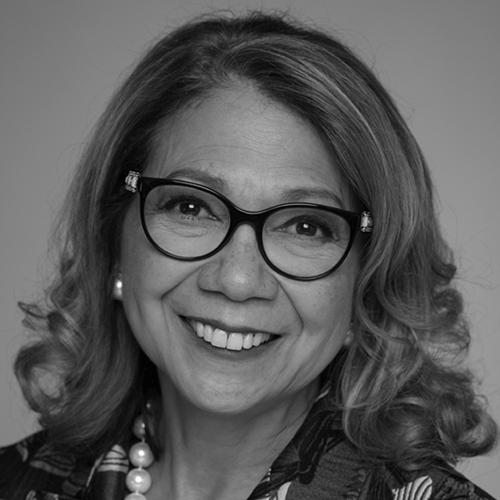
Mildred García, Ed.D.
President, American Association of State Colleges and Universities
The American Association of State Colleges and Universities (AASCU) has been deeply rooted in student success since its founding more than 50 years ago. Students are at the heart of AASCU, a constellation of nearly 400 public colleges, universities and systems.
Our members share a historic commitment to underserved student populations, a learning and teaching-centered culture, and research and creativity that advances their regions’ economic progress and cultural development.
AASCU institutions comprise 42 percent of the nation’s public four-year institutions. We enroll nearly 3 million undergraduates. Ninety percent of public four-year Historically Black Colleges and Universities are AASCU members. Forty percent of public four-year Hispanic-Serving Institutions are AASCU members, and 25 percent of Asian American and Native American Pacific Islander Serving Institutions are members of AASCU.
These diverse students enter our colleges with significant obstacles and hardships to overcome. Many arrive with fewer resources than their peers from elite universities, yet they are just as committed to obtaining a college degree. It is important that institutions consider the barriers students face while enrolled, work to eliminate them, and become truly student-centered.
On the frontier of progress
Each AASCU member is invested in making student success equitable and inclusive, and in 2017, six AASCU member institutions were selected to join the Frontier Set, a collaboration of 29 colleges and universities, and two state systems funded by the Bill & Melinda Gates Foundation, whose purpose is to identify, understand, and share what works to accelerate student success, especially among low-income, first-generation students of color and working adults.
At its core, the Frontier Set is about understanding transformation, with a view to inform scaling efforts that result in institutions increasing completion and closing equity gaps.
The Frontier Set has two outcomes: First, to contribute knowledge to the body of evidence on institutional transformation, and second, to increase performance on specific measures of student success.
These institutions undertake the venturesome work of transforming their institutions to improve student success outcomes, primarily focused on closing attainment gaps. Each is pursuing promising approaches in changing how their institutions operate so that they can better serve students. Their efforts will pave the way toward creating a more equitable future for our country.
CUNY College of Staten Island (CSI)
CSI focuses improving on improving its campus culture and student outcomes. It has seen a significant increase in full-time first-year students earning 30 credits or more, and aims to decrease overall time to graduation. Another example of its progress is its reduction in the number of academically dismissed students by more than 15 percent, which has been achieved through early intervention and a coordinated care approach. CSI has successfully used data to drive decisions and to reorganize services focused on the student experience.
New Jersey City University
New Jersey City University has added advisors, centralized advising, and supported the faculty’s focus on mentoring students. Other initiatives include peer advisor liaisons, summer and bridge programs, and the creation of a one-credit course known as Orientation to College, which teaches students how to succeed in college.
Northern Arizona University
Northern Arizona University saw a 50 percent increase in course completion rate after redesigning a large, introductory biology course that focuses on effective classroom teaching and course design. Many of NAU’s efforts are focused on intentional, comprehensive support for faculty teaching excellence. NAU also improved its advising, the way it places students in key English and math courses, and its approaches to teaching in large-enrollment courses. This has all resulted in a 4 percent increase in NAU’s retention rate.
Sam Houston State University (TX)
Sam Houston State University has redesigned its academic advising process to emphasize “Take 15” messages, which encourage students to enroll in 15 credit hours each semester in order to graduate on time. This campaign has resulted in first time-students attempting and completing more hours, as well as decreasing their time to graduation by a half year from 2014 to 2017.
Additionally, the university redesigned its math curriculum and has more full-time faculty teaching undergraduate students in first-year courses. The university was recognized by the Education Trust for closing the degree attainment gaps of Black and Latino students in a very short time period.
The University of North Carolina at Greensboro
The University of North Carolina at Greensboro (UNCG) has made student success its top priority by eliminating the graduation gap between black and white students, and nearly eliminating the graduation gap between Pell and non-Pell students. Over the past few years UNCG has introduced innovative new programs, including an academic success coaching program, a new summer bridge program for incoming first-year students and a college-readiness program for Latinx high school students statewide.
UNCG was recognized by the Education Trust in 2010, 2012, and 2013 as a national leader in closing achievement gaps; by Excelencia in Education in 2019 for its work with Latinx students; and by US News & World Report in 2019 as the top school in North Carolina for social mobility.
The University of Texas Rio Grande Valley
The University of Texas Rio Grande Valley’s unrelenting focus on academic advising led to an increase in the number and effectiveness of advisors. UTRGV also created student success teams housed in each of the colleges. The teams are comprised of faculty, academic administrators, advisers, and others who can provide insights into student experiences, and develop initiatives and programs to improve student success.
These six AASCU institutions are just a sample of the transformational work our members are doing to improve student success. Furthermore, the research on regional comprehensive publics is clear: AASCU institutions are engines of opportunity and social mobility, moving students up the income ladder to become engaged citizens, and productive members of our democratic society and communities.

